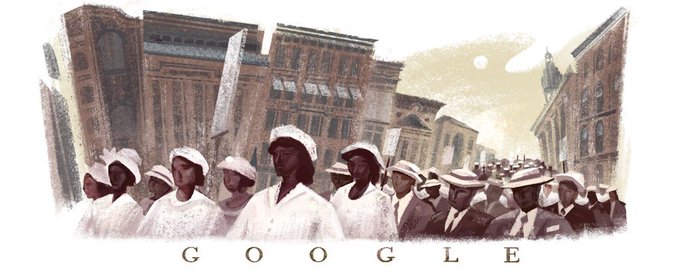1917年7月中到8月中,胡適之先生回安徽老家,見不了"未婚妻"......感嘆學校教育與社會需求不相干。
之前在上海看中國有的英文著作,都是上世紀的,比較日本丸善的書目 (一年前的著作全有)與商務印書館的,真是羞愧。
他留學期間,中文出版品,只有數本 (王國維的宋元戲曲等)是有水準的。
The “Silent Protest Parade” was the first mass African-American demonstration of its kind and a watershed moment in the history of the civil rights movement.
Google memorializes the Silent Parade when 10,000 black people protested lynchings

Silent protest parade in 1917 in New York City. Marchers were protesting against the East St. Louis riots, 1917. (Library of Congress).
They marched silently, nearly 10,000 strong.
One hundred years ago, on July 28, 1917, thousands of black people walked in silence down Fifth Avenue in New York City — an event commemorated by a Google Doodle on the website’s homepage.
The march, called the “Negro Silent Protest Parade,” was one of the country’s first mass protests against racial violence. It was organized by the NAACP to protest the horrors of lynchings, Jim Crow segregation and a horrifying race riot in East St. Louis. More than 100 black people had been killed by white mobs and more than 6,000 black people were burned out of their homes.
“We march because we deem it a crime to be silent in the face of such barbaric acts,” said a leaflet announcing the demonstration. “We march because we are thoroughly opposed to Jim-crow Cars etc., Segregation, Discrimination, Disfranchisement, LYNCHING and the host of evils that are forced on us.”
The protesters included W. E. B. DuBois, an NAACP founder and editor of the “Crisis” magazine, and James Weldon Johnson, then an NAACP field secretary and a Harlem Renaissance writer and composer, who had written the Negro National Anthem “Lift Every Voice and Sing” in 1900.
The marchers demanded that President Woodrow Wilson create legislation to protect the lives and property of black people.
Children led the parade, followed by women dressed in white and men in suits, bringing up the rear. They walked to the sound of muffled drums and carried flags of the United States, England, Haiti and Liberia.
Before the march, the NAACP calculated that more than 2,800 black people had been lynched in the United States over the course of three decades.
“Not a single murderer has suffered,” the NAACP said in a memorandum. “Two hundred thousand black men fought for your liberty in the Civil War. The first blood for American Independence was shed by a Negro—Crispus Attucks. We have fought for the liberty of white Americans in six wars; our reward is East St. Louis.”
In the East St. Louis riots, which began July 2, 1917, and lasted two days, white mobs indiscriminately stabbed black people, beating them and hanging them. Police did little to stem the violence. The riot erupted after weeks of tension over the use of black workers to replace striking white workers at a plant, according to an account by the National Humanities Center, a nonprofit group that has collected primary source material on the violence.
A St. Louis Post-Dispatch newspaper reporter wrote in a July 3, 1917, front page story what he witnessed:
“For an hour and a half last evening I saw the massacre of helpless negroes at Broadway and Fourth Street, in downtown East St. Louis, where black skin was a death warrant.”
A protester in the Silent March down Fifth Avenue carried a sign that said: “Pray for the Lady MacBeths of East St. Louis.”
Other marchers carried signs that said: “Your hands are full of blood.” Another sign read, “Mothers, do lynchers go to heaven?” Another read: “Race prejudice is the offspring of ignorance and the mother of lynching.”
James Weldon Johnson would later write about the Silent March in his autobiography, “Along This Way,” which was published in 1933.
“The streets of New York have witnessed many strange sights,” wrote Weldon, “but I judge, never one stranger than this; among the watchers were those with tears in their eyes.”


沒有留言:
張貼留言